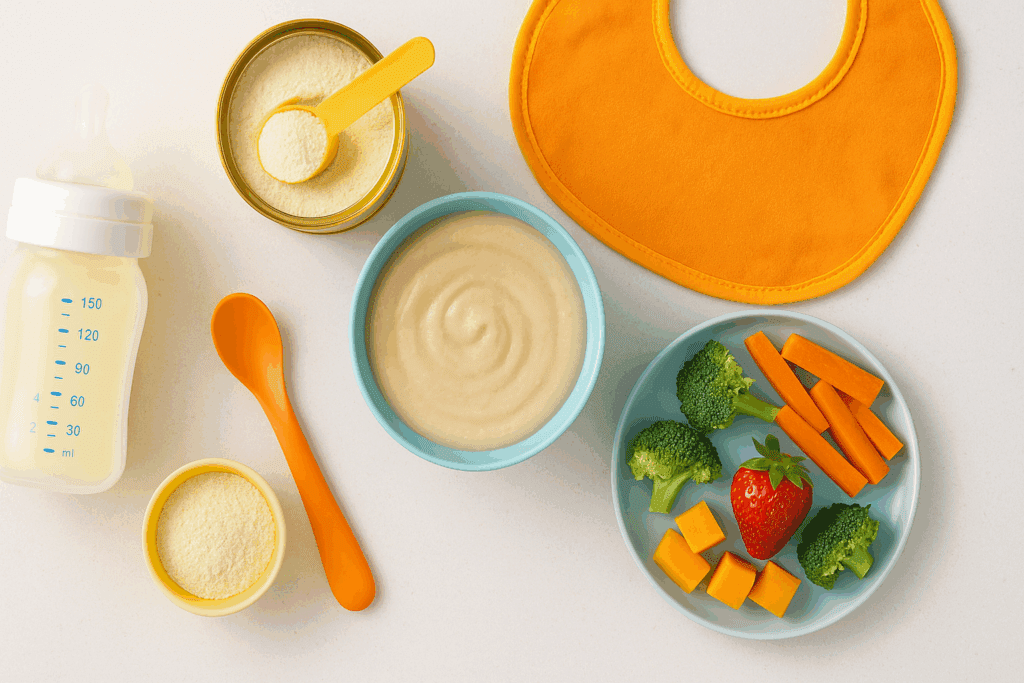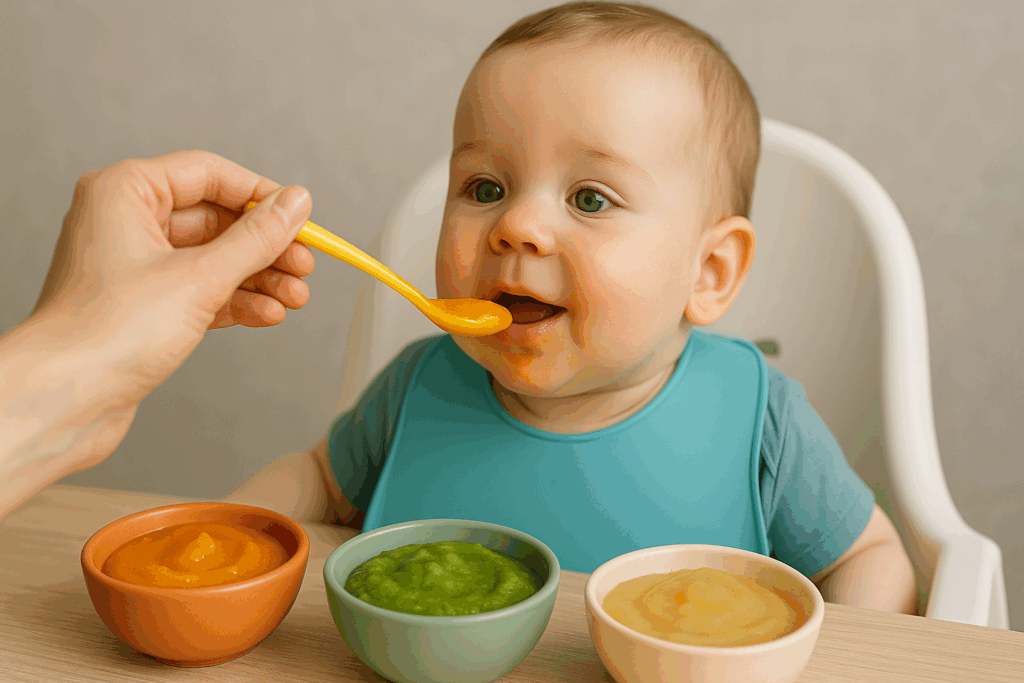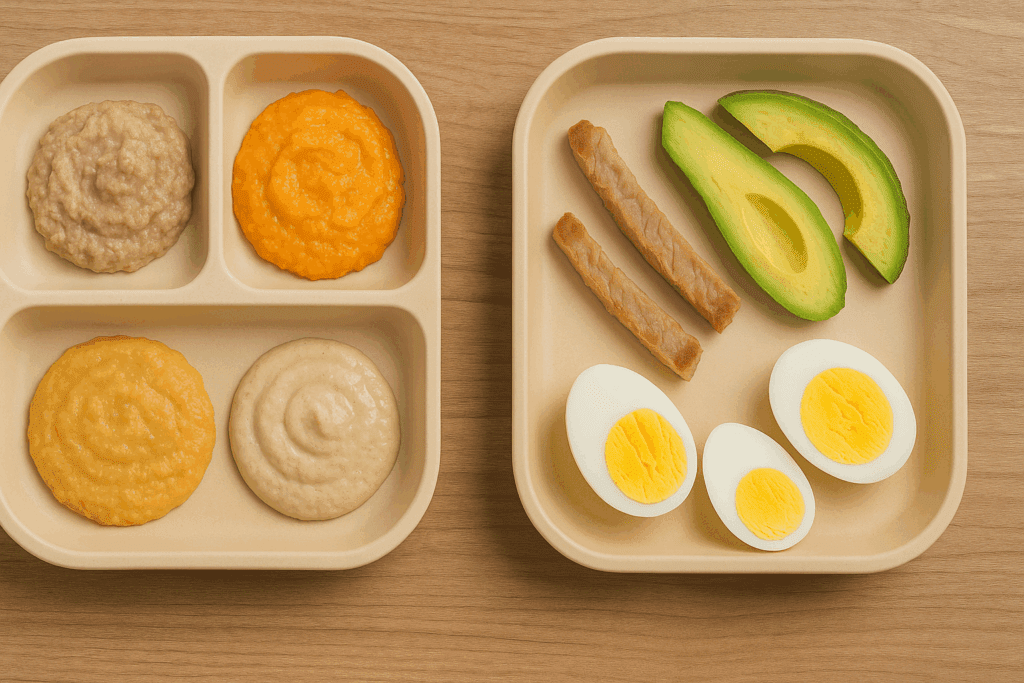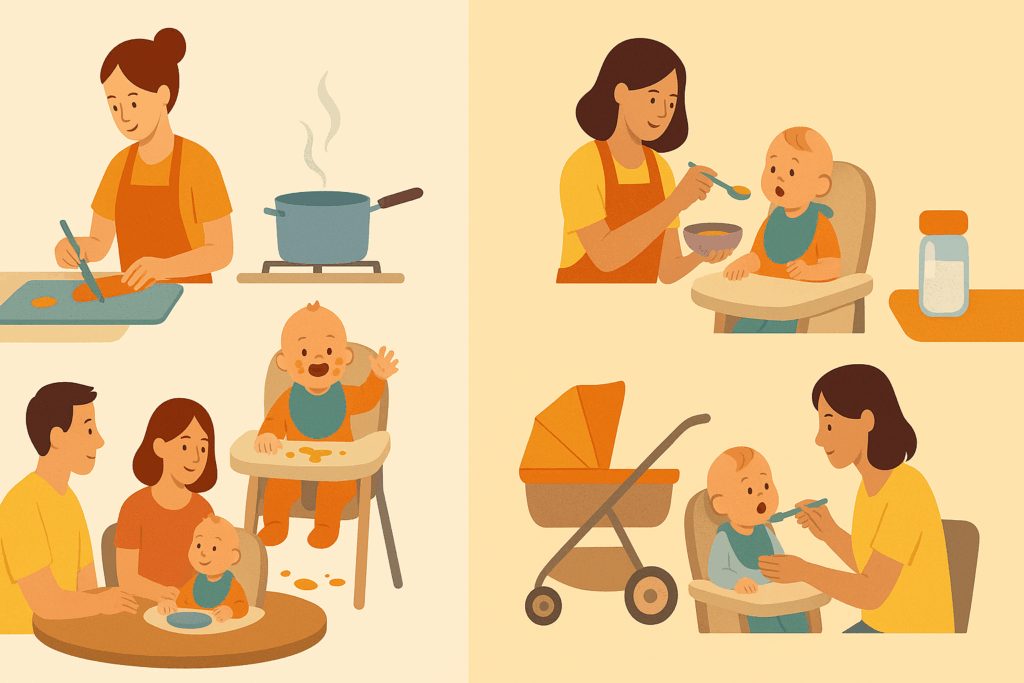Feeding an infant is a deeply personal journey that blends medical guidance, cultural traditions, and parental instinct. As new caregivers explore the evolving world of infant nutrition, they often encounter the choice between two primary approaches: baby-led weaning (BLW) and traditional spoon-feeding with purees. Understanding the differences and benefits of each method requires more than a surface-level overview. The debate surrounding blw vs puree highlights not just a difference in texture or method, but an evolving philosophy on child development, autonomy, and long-term eating habits. This guide provides an evidence-based, emotionally resonant, and expert-informed look into how parents can support their children through critical nutritional milestones.
You may also like: Essential Milestones in Baby Led Weaning: A Proven Guide to Nurturing Healthy Eating Habits

Understanding the Foundations of Infant Nutrition
Infant nutrition is not merely about caloric intake; it is a carefully orchestrated process of introducing vital macronutrients and micronutrients that support rapid growth and neurological development. From birth, breast milk or infant formula provides the complete spectrum of nutrients needed for the first six months of life. Around six months, the introduction of complementary foods becomes essential to meet the increasing demands for iron, zinc, and vitamin D, among others. This period marks a significant milestone where feeding transitions from exclusive liquid nourishment to a more diversified and textured dietary landscape.
The timing and method of this transition are critical. The readiness of the infant—evidenced by physical cues such as the ability to sit upright with support, showing interest in food, and the disappearance of the tongue-thrust reflex—should guide the process. Whether families choose baby led weaning vs purees, the infant’s developmental cues should be the compass rather than rigid timelines or societal pressures. Pediatricians emphasize the importance of introducing iron-rich foods early on, particularly for breastfed infants who may not receive adequate iron from milk alone. The nutritional strategies employed during this window can influence eating patterns, food preferences, and even metabolic outcomes in later life.

Exploring Baby Led Weaning: Principles and Practice
Baby-led weaning represents a departure from traditional feeding norms by placing the infant in control of their own food intake from the outset of complementary feeding. Rather than spoon-feeding mashed or pureed foods, parents offer safe, appropriately sized finger foods that the baby can grasp, chew, and self-feed. This autonomy encourages oral-motor skill development and allows the child to regulate their appetite naturally. The concept, popularized in recent years, aligns with a broader parenting philosophy centered around responsive caregiving and respect for the child’s agency.
One of the key advantages of BLW is its potential to reduce picky eating behaviors and promote a more diverse palate. By exposing infants to the texture, shape, and flavor of whole foods, BLW can foster a more adventurous approach to eating. Research suggests that babies who follow this method may be more likely to accept a variety of vegetables and family meals later in life. However, success with BLW requires vigilant supervision, a thorough understanding of choking hazards, and confidence in interpreting the baby’s hunger and satiety signals.
Critics of BLW raise valid concerns regarding nutritional adequacy, particularly with respect to iron intake and energy density. Without careful planning, infants may not consume sufficient quantities of essential nutrients, as their self-feeding capabilities are still developing. Therefore, BLW is best approached not as a rigid doctrine but as a flexible framework that can be combined with occasional spoon-feeding or pureed foods when needed. This hybrid model honors the principles of autonomy while safeguarding nutritional adequacy.

The Traditional Puree Approach: Structure and Reliability
Spoon-feeding purees has been the conventional norm in many cultures for generations. Parents typically begin with smooth, single-ingredient purees such as rice cereal or applesauce, gradually introducing more complex combinations and textures over time. This method offers a high degree of control, enabling caregivers to monitor intake and tailor nutrient-dense meals to meet specific developmental needs.
From a medical standpoint, purees offer certain advantages during the early stages of complementary feeding. They are easier for infants with immature oral-motor skills to manage and can be fortified with iron or other nutrients to address specific deficiencies. For example, iron-fortified cereals and pureed meats can play a crucial role in preventing iron-deficiency anemia, a common concern during infancy.
Purees also serve as a structured pathway for introducing allergens such as peanuts, eggs, and dairy in a controlled and gradual manner. This can be particularly reassuring for parents navigating family histories of food allergies. Furthermore, the traditional puree approach can be seamlessly integrated into childcare settings where caregivers may not be trained in the nuances of BLW. Despite its structured nature, this method can also be responsive when combined with cues from the baby’s hunger and interest in food.

blw vs puree: Nutritional Considerations at the Milestone Stage
When comparing blw vs puree through a nutritional lens, it’s important to assess the ability of each method to deliver critical nutrients during a period of rapid development. Iron remains a focal point in this discussion, given the high risk of deficiency in infants aged six to twelve months. Pureed meats, iron-fortified cereals, and legumes are typically more easily consumed via spoon-feeding. In contrast, BLW infants may struggle to ingest adequate quantities unless foods are carefully selected and prepared to optimize intake.
The bioavailability of nutrients is also a consideration. For instance, heme iron from meat is more easily absorbed than non-heme iron from plant sources. Parents practicing BLW must be proactive in offering soft strips of meat, boiled egg slices, or well-cooked lentils that their infant can handle safely. Moreover, pairing iron-rich foods with vitamin C sources like oranges or bell peppers enhances absorption, regardless of the feeding method.
Another essential nutrient is fat, which supports brain development. Full-fat dairy products, avocado slices, and nut butters can provide ample dietary fat in both feeding methods, though they must be served in safe forms to prevent choking. The protein content of meals, calcium intake, and exposure to fiber also vary depending on food selection. Therefore, whichever path parents choose, the key is dietary planning and consistency, ensuring the infant receives balanced meals rich in color, texture, and nutrients.

Developmental Skills: Motor Milestones and Feeding Method Synergy
Beyond nutrition, the choice between baby led weaning vs purees also intersects with motor development. BLW has been associated with earlier development of hand-eye coordination, pincer grasp, and chewing skills. The act of picking up a piece of food, bringing it to the mouth, and self-regulating intake promotes a cascade of fine motor and sensory experiences that reinforce neural pathways. This self-directed engagement with food also nurtures independence and confidence during mealtime.
On the other hand, spoon-feeding does not preclude motor development. As infants progress, parents can gradually offer thicker purees, lumpy textures, and soft finger foods to encourage chewing and manual dexterity. The use of a spoon by the child themselves can also be introduced, allowing for a transition toward self-feeding within a more structured context. What matters most is that feeding becomes an interactive, two-way process that responds to the infant’s cues and abilities.
Choking is a frequently cited concern with BLW, but studies indicate that with proper guidance and avoidance of known hazards—like whole grapes, raw carrots, and large chunks of meat—the risk is not significantly greater than with puree-fed infants. Supervised feeding, upright positioning, and CPR knowledge for caregivers are essential safety components, regardless of the chosen method. The overarching goal is to foster both safety and skill development, creating a secure environment for exploration.

Parental Confidence and Practical Lifestyle Factors
A key determinant in the success of any feeding method is the caregiver’s confidence and lifestyle compatibility. Some parents find the structure of purees reassuring, particularly when returning to work or relying on daycare providers. Purees can be batch-cooked, stored, and reheated, offering a sense of predictability that aligns with busy schedules. They also allow for precise tracking of how much the baby has eaten, which can be comforting during early stages of transition.
In contrast, BLW appeals to parents who prefer a more relaxed, child-led approach. It encourages family meals, reduces the need for special baby foods, and often fosters a shared culinary experience. However, it can also lead to anxiety in caregivers who worry about mess, food waste, or perceived nutritional gaps. Preparation of safe, graspable foods requires effort and attentiveness, especially in the early weeks.
Hybrid feeding methods that combine spoon-fed purees with finger foods offer a middle path. These approaches honor the infant’s growing autonomy while preserving the benefits of nutrient-rich purees. Over time, the balance can shift toward greater independence as the child becomes more adept at feeding themselves. The key is flexibility and responsiveness to both the child’s cues and the family’s unique circumstances.

blw vs puree: Cultural Influences and Global Perspectives
The debate over blw vs puree is not limited to clinical or developmental domains; it is also shaped by cultural practices, societal norms, and family traditions. In many non-Western cultures, infants are introduced to family foods early, often through a blend of mashed staples and hand-fed morsels. These practices predate formal weaning philosophies and reflect deeply rooted communal feeding behaviors.
In Western contexts, the popularity of BLW has surged in parallel with broader parenting trends that emphasize child empowerment, minimal intervention, and holistic development. Social media has played a significant role in disseminating BLW content, sometimes idealizing its outcomes without acknowledging the potential challenges. Conversely, spoon-feeding remains deeply ingrained in pediatric nutrition literature, with commercial baby food industries supporting its continued prominence.
Understanding global practices can broaden our perspective and remind us that feeding is not a one-size-fits-all endeavor. What remains consistent across cultures is the importance of nutrient density, food safety, and emotional attunement during mealtime. Parents are best served by considering their cultural context, trusted healthcare guidance, and their child’s individual temperament and development.
Practical Tips for Safe and Nutritious Feeding
Regardless of the chosen method, safety must always come first. Offering foods that are soft, appropriately sized, and free of choking hazards is non-negotiable. For BLW, this may mean steaming vegetables until tender, slicing fruits into finger-sized pieces, and avoiding small, hard items that could obstruct the airway. For puree-based feeding, progressing through texture stages is essential to promote chewing skills and prevent prolonged dependence on smooth foods.
Hygiene and food preparation are equally important. Hands, surfaces, and utensils must be clean, and perishable foods should be handled with care to avoid contamination. Introducing one new food at a time, especially allergens, allows for easier identification of reactions and supports a structured approach to dietary diversity. Whether following baby led weaning vs purees, the goal is a gradual, confident expansion of the infant’s food repertoire.
Responsive feeding—the practice of observing and respecting a child’s hunger and fullness cues—should guide all interactions. This involves recognizing signals like turning the head away, pushing food away, or closing the mouth. Encouraging but not forcing intake nurtures a positive relationship with food, supports self-regulation, and may help prevent future disordered eating behaviors. Mealtime should be a low-pressure, engaging experience that honors both nutrition and emotional connection.
blw vs puree: Emotional Impact and Family Dynamics
The emotional landscape of infant feeding is often overlooked, yet it plays a critical role in the success of any approach. Feeding is more than sustenance; it is an opportunity for bonding, learning, and mutual responsiveness. In the context of blw vs puree, this emotional connection may manifest differently, but its significance remains universal.
BLW encourages shared meals and eye-level interaction, which can deepen attachment and reinforce social learning. Infants watch caregivers eat, mimic their behaviors, and participate in the rhythm of family life. Puree feeding, when practiced responsively, can also be rich in emotional connection, with caregivers tuning in to cues and offering comfort and encouragement.
Family dynamics, including sibling involvement, parental mental health, and support systems, influence the feeding environment. A stressed or anxious caregiver may inadvertently create tension around mealtime, while a relaxed and present caregiver fosters a sense of safety. Feeding success is not determined solely by method but by the quality of the interaction and the emotional climate in which it occurs.
Choosing What Works: An Evidence-Based Approach
Ultimately, the choice between baby led weaning vs purees should be grounded in evidence, individualized to the child, and adaptable to the family’s needs. Pediatricians, dietitians, and occupational therapists can offer personalized guidance that aligns with the infant’s development and medical history. What works for one family may not work for another, and there is no universal “best” method.
Research supports the benefits and limitations of both approaches, and the emerging consensus favors flexibility. Combining the autonomy of BLW with the nutritional security of purees allows for a balanced strategy that evolves with the child. Trusting parental intuition, informed by expert advice and evidence-based resources, empowers families to navigate this complex terrain with confidence.
Feeding is a journey, not a destination. It unfolds in daily rituals, joyful messes, and the quiet triumphs of trying something new. Whether offering a spoonful of sweet potato or a slice of soft avocado, the intention behind the gesture matters most. Supporting infants through this transition with care, knowledge, and responsiveness lays the foundation for a lifetime of healthy eating and positive relationships with food.
Frequently Asked Questions About Infant Feeding: Advanced Perspectives on blw vs puree
How does parental temperament affect success with baby led weaning vs purees?
Parental temperament significantly influences the effectiveness and experience of both baby led weaning vs purees. Parents who value routine, predictability, and quantifiable progress often feel more comfortable with traditional puree feeding, where intake can be measured and food is usually less messy. Conversely, those with a more flexible, patient, and experimental approach to caregiving may thrive with baby led weaning, embracing the unpredictability and mess as part of the learning process. Interestingly, the chosen feeding method can also impact parental stress levels—caregivers who resist their natural inclinations may feel more frustrated, regardless of the method’s theoretical advantages. Understanding and honoring your own temperament, alongside your baby’s developmental readiness, ensures a more harmonious and effective feeding journey.
What are some hidden costs or resource considerations when comparing blw vs puree?
While both feeding methods may appear cost-neutral at first glance, there are subtle financial and resource differences that can influence long-term feasibility. Puree feeding often involves purchasing blenders, food processors, and storage containers, or investing in store-bought baby food pouches, which can accumulate costs over time. On the other hand, BLW encourages the use of whole family foods, but it may result in greater food waste as infants explore and discard items. Time is also a factor—puree preparation can be done in batches, offering convenience, whereas BLW often requires daily preparation of safe, fresh, and finger-friendly meals. Evaluating not just monetary costs but time, food waste, and equipment needs can help families make informed choices that align with their lifestyle.
Are there long-term behavioral or psychological differences linked to blw vs puree?
Emerging research suggests there may be subtle long-term behavioral differences between children who follow baby led weaning vs purees. Some studies point to increased food autonomy, self-regulation, and less fussiness in children who practiced BLW, as they were empowered to control their intake from an early age. However, these findings are nuanced and often dependent on the quality of the parent-child interaction rather than the method itself. Children who were spoon-fed in a responsive, non-coercive environment also show healthy eating habits and positive attitudes toward food. Ultimately, it’s not just about the feeding approach but how mealtimes are framed emotionally and socially—consistency, patience, and encouragement are key regardless of the method.
How can families transition from purees to finger foods without switching entirely to BLW?
Many families begin with purees for safety and control, but later want to encourage more autonomy without fully embracing BLW principles. A gradual transition involves introducing mixed textures, such as mashed foods with soft chunks, followed by easily dissolvable finger foods like banana slices or soft-cooked vegetables. Encouraging self-feeding with a spoon while still offering purees can build confidence and motor skills. Families can adopt a modified BLW approach by offering finger foods alongside spoon-fed options during the same meal. This hybrid strategy supports developmental progress while maintaining nutritional assurance, providing a tailored solution for families navigating the blw vs puree spectrum.
Can the choice between baby led weaning vs purees impact dental development?
Oral development is closely tied to the textures and mechanics of food intake, making the method of feeding a relevant factor in early dental health. BLW may promote jaw strength and encourage chewing motions earlier, which can support proper alignment and oral muscle coordination. Purees, especially if prolonged, may delay these mechanics, though they do not inherently cause dental issues. However, what matters most is texture progression—infants need exposure to chewable foods before 9–10 months to foster robust oral-motor skills. Additionally, caregivers should avoid offering high-sugar purees or sticky foods, as these may contribute to early tooth decay. The emphasis should be on diversified textures and oral stimulation, not just the format of the food.
blw vs puree: How do social settings influence feeding choices and outcomes?
Social environments play a powerful role in shaping feeding practices and their emotional tone. In communal cultures or large families, baby led weaning often integrates naturally into shared mealtimes, allowing babies to mimic and model eating behaviors from siblings and adults. In contrast, puree feeding may dominate in settings where individualized feeding is the norm or where time constraints necessitate efficiency. Social support also matters—caregivers surrounded by like-minded parents may feel more confident in their choices, while those facing criticism or misunderstanding might struggle with consistency. Whether choosing blw vs puree, creating a supportive, informed community around feeding can buffer stress and reinforce positive habits for both parent and child.
Is there a connection between early feeding styles and food allergy development?
Recent guidelines emphasize early and diverse allergen introduction as a preventive strategy against food allergies. Both feeding methods can accommodate this recommendation, though the approach may differ. Purees allow for controlled allergen exposure—such as incorporating powdered peanut or scrambled eggs into smooth textures—especially useful for monitoring reactions. BLW also supports early exposure, often through offering allergenic foods in their whole form, such as soft-cooked eggs or nut butter on toast. What’s crucial is not the method but the timing and frequency of exposure, ideally starting between 4 to 6 months, in consultation with a healthcare provider. Families concerned about allergies should prioritize evidence-based strategies over rigid adherence to either baby led weaning vs purees.
blw vs puree: What innovations or technologies are shaping the future of infant feeding?
The landscape of infant nutrition is evolving, with emerging innovations influencing how families implement blw vs puree in practical ways. Smart baby spoons that change color based on temperature, app-connected feeding trackers, and AI-assisted meal planners are redefining convenience and safety. There are also nutritionally tailored puree subscription services that allow for stage-based customization and allergen exposure scheduling. For BLW enthusiasts, safe slicing gadgets and textured grip plates improve independence and reduce mess. In both cases, advances in child nutrition science and biotechnology may soon allow for micro-nutrient scanning of homemade meals, helping caregivers ensure dietary adequacy regardless of method. These developments are expanding possibilities and lowering barriers for diverse feeding preferences.
How does personality type influence a baby’s success with baby led weaning vs purees?
Just as adult personality shapes caregiving style, a baby’s temperament can influence which feeding method feels most intuitive and successful. More cautious or sensitive infants may initially resist unfamiliar textures or self-feeding, benefiting from the predictability of purees and caregiver interaction. Meanwhile, assertive or curious babies might thrive on the independence offered by BLW, eagerly exploring textures and tastes. Observing your baby’s reaction to new foods, willingness to self-feed, and tolerance for mess can inform a personalized approach. Success with baby led weaning vs purees often hinges less on strict adherence and more on adaptive alignment with your child’s unique disposition.
What are some less-known emotional cues that indicate feeding readiness or resistance?
Beyond physical milestones, emotional and behavioral signals offer insight into an infant’s feeding readiness. These include sustained eye contact with caregivers during mealtimes, mimicking chewing motions, or reaching toward food with focused intent. Conversely, signs of resistance may manifest as arching the back, turning the head repeatedly, or fussing at the sight of food. These cues are essential when navigating the continuum between baby led weaning vs purees, as they guide caregivers in pacing and customizing the approach. Tuning into these subtle behaviors fosters a sense of trust and cooperation that is foundational for a positive relationship with food and autonomy in eating.
Conclusion: Reflecting on Infant Feeding Choices: Nourishing the Body, Heart, and Mind
As caregivers reflect on the journey of infant feeding, the question of blw vs puree becomes less about choosing sides and more about understanding what best serves the child. This guide has explored the nutritional foundations, developmental benefits, cultural contexts, and emotional dynamics of each method, offering a holistic perspective rooted in evidence and empathy. Both approaches, when applied thoughtfully, can lead to thriving outcomes that align with the milestones of healthy growth.
Feeding is not just a physical act but an emotional and relational one. It is in the shared gaze over the high chair, the delighted giggle at a new flavor, and the patience extended during a messy meal that the true essence of nourishment is revealed. By embracing the nuances of baby led weaning vs purees and honoring the individuality of each infant, families can create a feeding experience that nurtures the whole child—body, heart, and mind. In doing so, they lay the foundation for not only strong nutritional health but also lifelong confidence, curiosity, and joy in the journey of eating.
Further Reading:
Baby-Led Weaning vs. Purees: Pros & Cons
Baby-led weaning vs. purees: Which method is better?
Baby-Led Weaning Vs. Purées: Which Feeding Approach Should You Use?



